
DW Spectrum Enterprise FAQs
-----------------------------------
Related Digital Watchdog VMS Apps: DW Spectrum Enterprise
Last Edit: August 19, 2025
-----------------------------------
A New Security Frontier
Digital Watchdog’s launch of DW Spectrum Enterprise introduces a new hierarchical structure that Channel Partners and their users can use to streamline the management of DW Spectrum systems, sites, devices, and user permissions.
While DW Spectrum Enterprise and Professional may sound like two separate entities, the two are intended to be used as a single, unified platform. All of the features and benefits of DW Spectrum Professional are still available, in addition to Digital Watchdog’s dedication to creating seamless scalability, centralized management, and unified site organization, new features make coordination between Channel Partners and Managed Service Providers easier to visualize and deploy.
This document will provide you with answers to some of the most frequently asked questions about DW Spectrum Enterprise and what your subscription can offer you.
- For More Information on DW Spectrum, visit the DW Spectrum Components and Resources site.
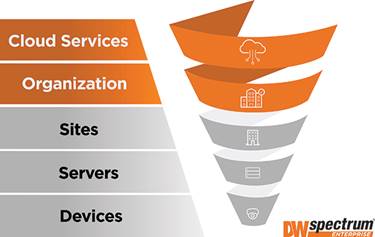
Frequently Asked Questions
What is DW Spectrum Enterprise?
DW Spectrum Enterprise is a subscription-based “Software-as-a-Service” (SaaS) that is designed for intelligent video and data management. It includes all features available in DW Spectrum Professional, with exclusive capabilities that enable organizations to be unified at the cloud level and help administrators to gain full control and visibility of all their DW Spectrum System deployments, regardless of geographic location. DW Spectrum Enterprise is the foundation of fast, easy-to-use, proactive video security solutions.
What is the difference between DW Spectrum “Professional” and “Enterprise”?
DW Spectrum Professional is the core system component for a site. It includes the local Server and Client instances for the End User’s DW Spectrum System. Any DW Spectrum deployment that has not been added to a Channel Partner’s Organization can be considered as a “DW Spectrum Professional” level system.
DW Spectrum Enterprise is built on the foundation of DW Spectrum Professional and includes all the features available in Gen 6. DW Spectrum Enterprise takes your system to the next level with infinite scalability and unified, cloud-centralized management. In addition, DW Spectrum Enterprise brings DW Maps, DW Connect managed service provider tool, and add-on capabilities such as DW Cumulus.
- DW Maps – an intelligent Geographic Information System (GIS) mapping tool that enhances any DW Spectrum deployment with advanced geolocation data visualization. DW Maps allows users to visualize their systems globally and experience spatial analysis to make informed decisions about their security options. It transforms users’ ability to monitor and manage IP devices through a simple, unified interface.
- Free lifetime access for early adopters.
- DW Connect – a powerful, comprehensive subscription management portal for Managed Service Providers (MSPs) to oversee their Channel Partners and Organizations, manage subscriptions, ensure appropriate billing and enhance control over their profits. Management of sub-partners, organizations (End Users), licenses, and user access is made available from a single, interactive dashboard.
- DW Cumulus – a hybrid storage solution for Digital Watchdog edge products (MEGApix Ai CaaS) and onsite DW Blackjack Ai Servers. Powered by Seagate Lyve, this solution opens local storage and allows for true scalability from terabytes to petabytes. DW Cumulus is a good option for organizations who are seeking to embrace the benefits of a secure cloud storage solution, while still retaining onsite, local storage for fully maintained and easy-to-use storage redundancy.
What do the terms “Channel Partner”, “Managed Service Provider”, “End User”, and “Organization” mean in DW Spectrum Enterprise?
- Organization – defined as the overall grouping of sites registered within DW Spectrum Enterprise. Each Organization is managed by the Channel Partner, who oversees and monitors multiple sites/deployments of individual DW Spectrum Systems.
- Channel Partner (CP) – defined as the top of an Organization. For example, an alarm company who has multiple customers (End Users), would be the “Channel Partner”.
- Managed Service Provider (MSP) – this is an optional level that Channel Partners can become to manage their own subscription-based service for their End Users. MSPs are essentially Channel Partners who provide their own subscription services through DW Spectrum Enterprise.
- End User – defined as the local and cloud user(s) of a DW Spectrum System.
Can I keep my DW Spectrum Professional System?
Yes, you can. DW Spectrum Enterprise does not a required upgrade. The DW Spectrum Client user interface options will still be usable for your individual system viewing and management, in addition to the expansion of DW Spectrum Enterprise options. If you are using DW Spectrum Gen 6.0 or newer, you can continue to use the same hardware as your “Pro” system. FQDN options to connect, like DW Cloud, will still be available for remote connection.
Be aware that upgrading to DW Spectrum Enterprise will automatically convert your Professional recording licenses into “credits” when you choose to switch to the DW Spectrum Enterprise subscription.
Can I convert my DW Spectrum Pro Licenses to a DW Spectrum Enterprise subscription?
Yes, if you want to convert your DW Spectrum Professional recording licenses for a DW Spectrum Enterprise subscription, contact your DW Sales Representative.
Be aware that active DW Spectrum Professional Licenses will be converted to 24-month subscription credits when a site is added to a DW Spectrum Enterprise Organization. The change cannot be reversed.
Can I convert the free licenses that came with my DW Blackjack Server into subscription credits?
Any DW Spectrum Pro license that was included for free, with server purchases, gained through double-down promotions or purchased separately, can be converted into a single device 24-month Enterprise subscription.
Can I convert only part of my “Professional” licenses into Enterprise subscription credits?
Unfortunately, conversion to DW Spectrum Enterprise involves converting ALL existing DW Spectrum Pro licenses. For example, if you are a Channel Partner and have multiple sites of DW Spectrum Professional deployed in different locations for different end users and want to keep select sites offline/private on a closed network, it is optional to add all your end user sites to the Organization.
If you want to learn more about DW Spectrum Enterprise, you can book a demo.
How do Enterprise Subscriptions work?
DW Spectrum Enterprise Subscriptions are sold by the number of devices. Your options include 1, 4, 8, 16, 24, or 48 devices over a period of 1-year to 3-years. Once the subscription has been purchased, your Managed Service Provider (MSP) will open a DW Connect account for you, where you can activate a subscription and add it to your devices.
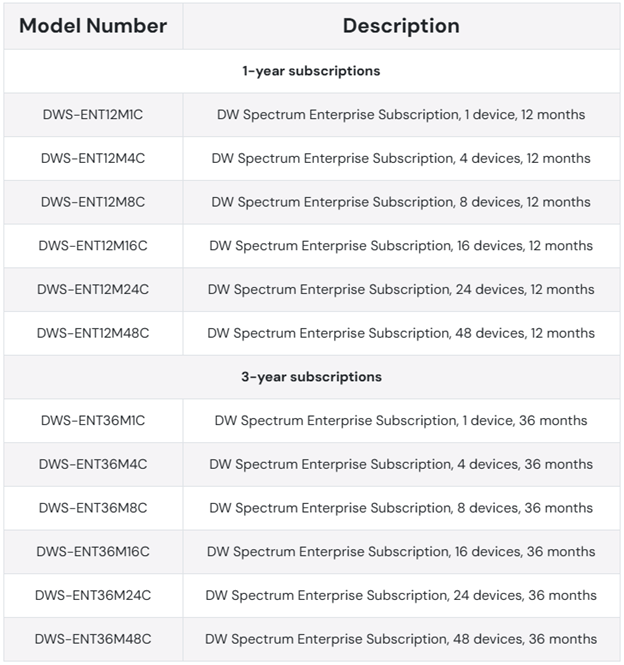
Do I need a subscription for each device that I have?
Yes, whether you are converting DW Spectrum Professional licenses or are purchasing new DW Enterprise subscriptions, it is recommended that you have a subscription for each of the devices in your organization.
Where do I find my Managed Service Provider (MSP) information?
In DW Spectrum 6.0, the contact information that can be found in the DW Spectrum Client’s Main Menu > About option. MSPs can enter their information so that customers can easily find the contact information through their desktop client.
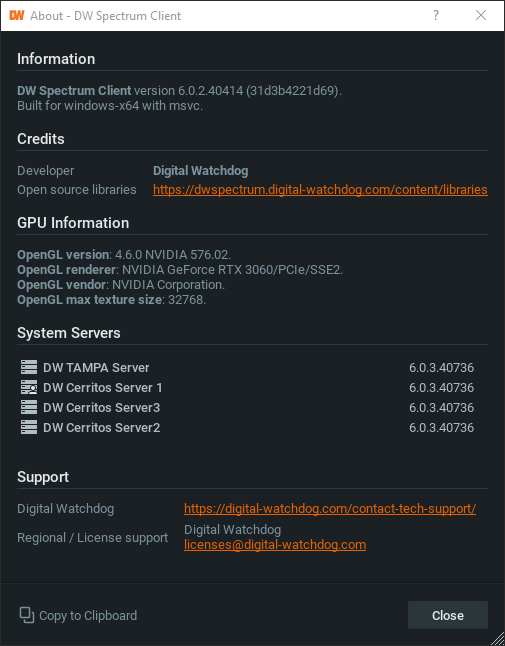
How do I add more subscriptions?
Adding, updating, or removing subscriptions can be done easily and instantly. Contact your Managed Service Provider (MSP) to convert your licenses to Enterprise subscriptions, update existing subscriptions, or add new devices.
If you already have active subscriptions and wish to purchase additional subscriptions, the existing and new subscriptions will be adjusted to have a unified expiration date. This process is known as “Co-Term”.
What is “Co-Term”?
“Co-Term” or “Co-Termination”, refers to adjusting the subscription time range by combining existing subscriptions and new subscriptions into a single expiration date, regardless of the purchase date.
This also means that if an account has multiple subscriptions activated at different times, all subscriptions are bundled together to share the same renewal or Co-Term renewal date instead of each subscription having a different renewal date for each individual device.
Understanding DW Subscriptions - YouTube
What are the benefits of Co-Term for End Users?
The Co-Term method simplifies the subscription renewal process and billing cycle, making things more efficient. Co-terming reduces the risk of subscriptions expiring without user knowledge, which would otherwise unexpectedly impact daily operations and prevent users from accessing data.
Co-terming converts all subscriptions into a single contract, saving administrative resources, time and effort.
How is Co-Term calculated?
Regardless of how many subscriptions were applied or when they were applied, the subscription expiration date for all subscriptions will be the same. This is accomplished by averaging all active subscriptions and dividing by the Organization’s device count.
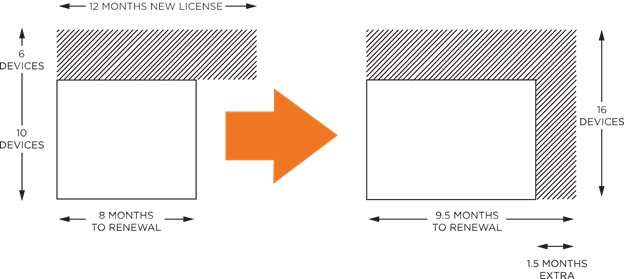
What are some Co-Term examples?
The Co-Termination date is a weighted average of the subscription purchased and claimed by an Organization.
Example A (multiple subscriptions purchased on the same date)
- An Organization had two separate Enterprise subscriptions – one for 2x single-device subscriptions, spanning one year (12 months) and another for 1x single-device subscriptions spanning five years (60 months). The Co-Termination value would be calculated for all three subscriptions.
((60-months x 1 subs) + (12-months x 2 subs)) /3 subs (total) = 28-months
Assuming all three licenses were applied on the same day, the Organization would have a Co-Term date of 28-months from the start date of the licenses.
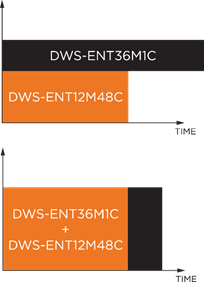
Example B (multiple subscriptions purchased at different dates)
- If the subscriptions were not applied simultaneously, for example, if five additional years of subscription were added halfway through a one-year subscription, the Co-Term calculation would take that into effect. In this case, the calculation would equate to 28-months total for all three subscriptions.
((60-months x 1 sub)+(6-months x 2 subscriptions) /3 subs = 24 months
Do changes to the number of devices I have affect my subscriptions?
The Co-Termination date of the subscriptions depends on the current device count. Subscription activation keys can be modified based on duration and the number of devices. Adding devices would shorten the co-termination date.
Are my subscriptions tied to my devices?
No, subscriptions are fully transferrable between devices and are locked in by expiration only.
What happens if I add devices in the middle of my subscription term?
Digital Watchdog sells 1-year and 3-year subscriptions. When you add a subscription to an Organization with an existing subscription, the Co-Term date is recalculated to a single termination date for all your subscriptions.
You mention five-year subscriptions. How is that possible if DW only sells 1-year and 3-year subscriptions?
You can purchase and apply differing levels of subscription. For example, to equate to a five-year subscription, one would purchase two 1-year subscriptions and one 3-year subscriptions.
(1-year sub x 2 keys) + (3-year sub x 1 key) = 5-year subscription
What is the exact unit of time used for the subscription calculations?
It is calculated in days. Once the exact expiration time is computed, the subscription expires on the nearest day and is enforced at midnight, local time.
What is my subscription start date?
Subscriptions are considered active and begin to count down from when they were activated in DW Connect, not when they were purchased.
What are “Add-on Subscriptions”?
Subscriptions sold based on a specific add-on, such as DW Cumulus or METApix, which are optional and sold separately. While the add-ons are sold independently, their expiration date is linked to the Enterprise subscription’s expiration date. If an enterprise subscription expires and is not renewed, all related add-ons will no longer be available.
Is there a grace period for expiration?
A subscription will go into a 30-day grace period if not renewed.
It is recommended that subscriptions be renewed automatically. This can be established through your DW Connect MSP tool. Users can set up reminders and process payment updates or changes.
Recording is still enabled during this time, and all systems are accessible over the local network for local users. There is no access to systems via DW Cloud upon expiration.
A subscription can be changed back to an “Active” status by purchasing new subscriptions. Renewing expired subscriptions is not possible currently. Should an Organization choose not to renew their subscription services, all Enterprise subscriptions will be changed to a “Shut Down” status. In this case, recording is stopped, and the systems are only accessible over the local network, without access to other systems over DW Cloud.
Users can downgrade the DW Spectrum Professional services by purchasing new recording licenses per device.
______________________________________________________________________________
For More Information or Technical Support
DW Technical Support: https://www.digital-watchdog.com/contact-tech-support/
DW Sales: [email protected] | www.digital-watchdog.com
Rev: 06/25 Copyright © DW. All rights reserved. Specifications and pricing subject to change without notice. ![]()



